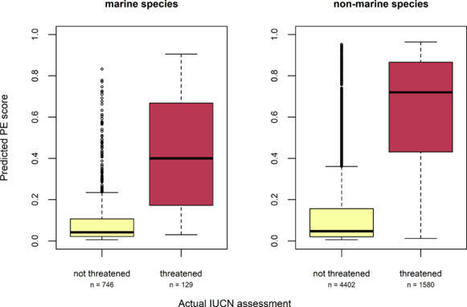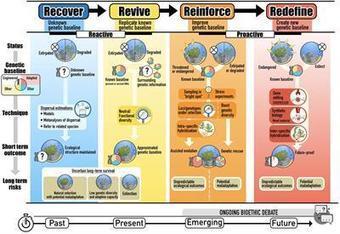The IUCN Red List of Threatened Species is essential for practical and theoretical efforts to protect biodiversity. However, species classified as “Data Deficient” (DD) regularly mislead practitioners due to their uncertain extinction risk. Here we present machine learning-derived probabilities of being threatened by extinction for 7699 DD species, comprising 17% of the entire IUCN spatial datasets. Our predictions suggest that DD species as a group may in fact be more threatened than data-sufficient species. We found that 85% of DD amphibians are likely to be threatened by extinction, as well as more than half of DD species in many other taxonomic groups, such as mammals and reptiles.
Get Started for FREE
Sign up with Facebook Sign up with X
I don't have a Facebook or a X account
 Your new post is loading... Your new post is loading...
 Your new post is loading... Your new post is loading...
|

Agrodoc Ouest's curator insight,
April 20, 2020 3:55 AM
La détérioration globale des habitats des écosystèmes marins a conduit à la nécessité d'interventions actives pour stopper ou inverser la perte de la fonction écologique. La restauration a toujours été un outil essentiel pour inverser la perte d'habitats et restaurer les fonctions, mais on ne sait pas dans quelle mesure cela sera suffisant sous les climats futurs. Les technologies génétiques émergentes permettent aujourd'hui de restaurer de manière proactive l'adaptabilité des espèces cibles aux conditions environnementales futures prévues, ce qui ouvre la possibilité de renforcer la résistance aux stress futurs dans les habitats dégradés et menacés. Ainsi, le choix de restaurer les bases historiques ou d'anticiper l'avenir reste une décision clé qui influencera le succès de la restauration face au changement environnemental et climatique. Nous présentons ici un aperçu des différentes motivations de la restauration - récupérer ou faire revivre les habitats perdus ou dégradés dans leur état actuel ou historique, ou renforcer ou redéfinir les conditions futures. Nous nous concentrons sur les choix génétiques et adaptatifs qui sous-tendent chaque option et sur les conséquences qui en découlent pour la réussite de la restauration. Ces options couvrent un éventail de trajectoires possibles, d'avancées technologiques et d'acceptabilité sociétale, et représentent un cadre pour faire progresser la restauration des espèces formant des habitats marins dans le futur.
|












Borgelt, J., Dorber, M., Høiberg, M.A. et al. More than half of data deficient species predicted to be threatened by extinction. Commun Biol 5, 679 (2022). https://doi.org/10.1038/s42003-022-03638-9
via @Shoal_Org @david_tickner @CommsBio